Chocolate is the treat associated with Valentine’s Day. If you are a Chocolate lover or just Chocolate-curious, you will learn some interesting and fun facts to dazzle your Valentine and set the mood for a warm (or hot) encounter.
Let it not be said that we romantics here are YapaTree do not cater to your most important priorities!
We will shed light on the origins of chocolate and Valentine’s Day and other traditions like Cupid. Then we reveal the magical synthesis of both into this delicious and seductive tradition of love and romance before sharing where to find all things chocolate in Cuenca.
Tip: try out the world’s first poetic Valentine’s Day greeting (below) on your partner and watch them melt.
Ready? Let’s sink our teeth in!
Origins of Chocolate
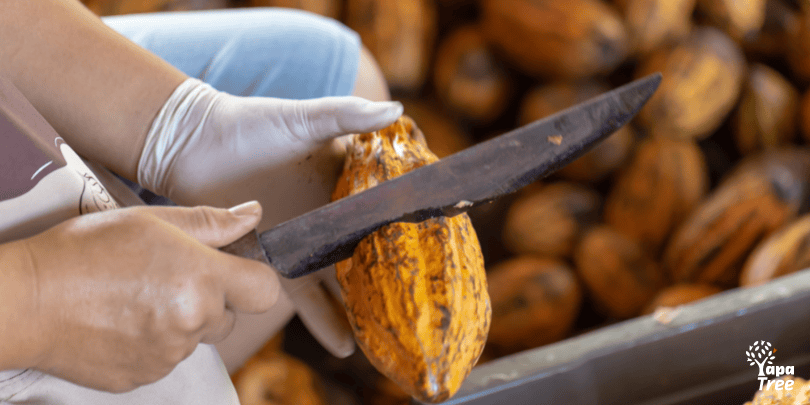
Chocolate has long been thought to have originated in Colombia and Panamá about 4,000 years ago – until now. New evidence points to its origin in the Amazonian jungles of Ecuador about 5,500 years ago.
This new evidence stems from researchers from the University of British Columbia. They had been performing archaeological digs looking for the early use of grains, such as maize, beans, and manioc. They found these coated on shards of pottery and concluded these were staples in the diet of early Amazonian peoples. The Amazon jungles likely hold the greatest source of cacao beans in the world, but their origin had never been questioned.
On a lark, researchers wondered if they could find evidence of chocolate on these same shards of pottery. The hypothesis was dubious, as such a substance would not survive the humid conditions of the jungle. However, to their surprise, they found biomolecules of the cacao bean on the pottery, and DNA proved this to be true.
Reconstruction of the pottery and findings of other ceramics showed the cacao bean was used to make a drink. The discovery of vessels and their remains in tombs and at ceremonial locations indicates the significance of the chocolate beverage. It was a prized drink, reserved for special occasions.
Why were Colombia and Panamá thought to be the initial findings of chocolate? This can only be hypothesized. Perhaps migrating individuals carried the beans north to plant in their new gardens, or perhaps traders used these in exchange for other goods.
Michael Blake, anthropologist and Amazonian researcher, speculates that the cacao bean;
“with its prominent pods growing right out of the trunk and main branches–all within easy reach–and its sweet pulp, that the very first people to occupy the tropical forests of South America would likely have used it.”
Michael Blake, Nature Ecology & Evolution, October 29, 2018
Ecuador is known for its high quality chocolate, especially its dark chocolate. You will find it rich and complex, with hints of nuts, fruit, and spices due to the particular soil and climate of the jungles. Chocolate is harvested by hand in the Amazon from pods growing on the Theobroma cacao tree, a small understory tree indigenous to Central and South America. These pods are plucked by hand, fermented, dried, roasted, and ground by farmers who know the traditional methods to extract the cocoa bean. Specific regions of trees produce beans that taste different from each other.
Ecuador is also the fifth largest exporter of chocolate worldwide, making chocolate a major economic contributor to the economy.
Ecuador’s chocolate producers are well positioned to benefit from the popularity of chocolate to be given as gifts, particularly on Valentine’s Day.
Saint Valentine – There were 3!
The Roman church recognized three martyred Valentines as saints. One of these, St. Valentine of Rome, was a priest who performed marriages against the decree of Emperor Claudius who declared single men made better soldiers. So he outlawed all marriages and engagements in Rome. Valentine opposed Claudius’ dictum, performed marriages, and was beheaded for doing so about 270 A.D.
The second Valentine, St. Valentine of Terni (also Italian), was imprisoned for having helped prisoners escape the brutality inflicted on them. He fell in love with a young girl who often visited him at the prison. At one point, he sent her a message signed From Your Valentine, an expression still used today. This is a beautiful story but it cannot be corroborated. This Valentine became quite popular outside of Rome in today’s England and France.
The last St. Valentine emigrated from North Africa to Rome, where many North Africans helped form the Roman world. Little is known about this Valentine except he would have been a black man. No romantic associations have been linked to this Valentine. He was martyred in North Africa in 270 A.D. because he refused to renounce his faith.
Who is the real St. Valentine? All three were martyred, but only the first two were associated with romance. History has come to associate the first Valentine of Rome as the saint of love and the patron saint of Terni. This Valentine was beheaded, today an unlikely association with love. In actual practice, since we know so little about these men, all three have merged into one person known as Valentius, a name meaning strong or powerful.
Today, the Roman Catholic Church no longer recognizes St. Valentine. His feast day was purged following the Second Vatican Council in 1969, but he is still recognized as the patron saint of lovers, epileptics, and beekeepers.
Genesis of Valentine’s Day
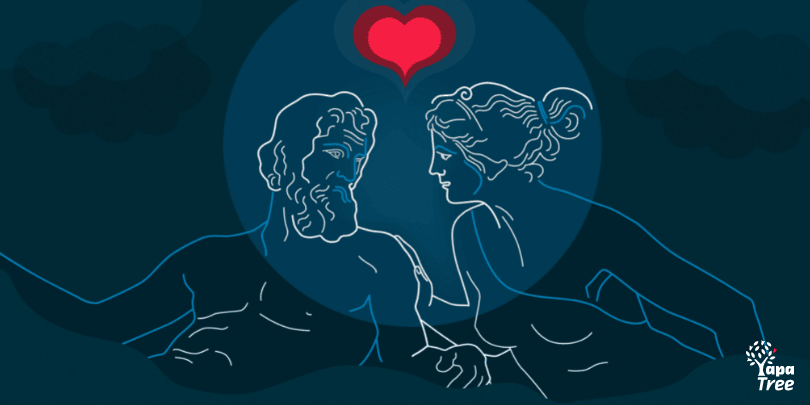
Every year throughout many countries, Valentine’s Day is celebrated on February 14th. It is a day to express love and fondness to another, often with chocolate, wine, roses, greeting cards, or other gifts. How did these expressions of love come about, and why on this particular day?
Valentine’s Day is shrouded in some mystery. February has long been associated with romance, though that association was not recognized until the 14th century. The Day has elements of both Christian and secular Roman tradition deriving from the pagan celebration of Lupercalia, a feast day celebrating the god of agriculture as well as the founders of Rome – Remus and Romulus.
Prior to the 5th century, a goat was sacrificed and its hide stripped into ribbons, dipped into the goat’s blood, and slapped gently against women and crops to promote fertility for the year. Hence the color red is associated with Valentine’s Day. In Rome, single women would inscribe their names on small pieces of paper, place them in an urn, and single men would randomly select a name to determine their future spouse.
In 492 A.D., the Church outlawed this secular practice when Pope Gelasius chose to combine St. Valentine’s Day with the Feast of Lupercalia. In 495 A.D., he declared February 14th would be St. Valentine’s Day. Residents of England and France also chose the middle of February to celebrate romance, having witnessed this as a time when birds began their mating season.
The Earliest St. Valentine’s Day Greetings
Love and romance were not always associated with Valentine’s Day. The first linking of these passions to February 14th occurred in 1375 when Geoffrey Chaucer wrote his poem Parleament of Foules (modernized to Parliament of Fowles). The reference to the mating season of birds is clear.
Chaucer wrote, “For this was sent on Seynt Valentyne’s day / Whan every foul cometh ther to choose his mate.” This poem is now considered to be the first reference to love on Valentine’s Day.
The oldest known written Valentine greeting was composed in 1415 by Charles, French Duke of Orleans, to his wife while he was imprisoned in the Tower of London following his capture during the Battle of Agincourt. Some years later, King Henry V hired John Lydgate to compose a greeting that he sent on Valentine’s Day to his wife, Catherine of Valois.
Cupid
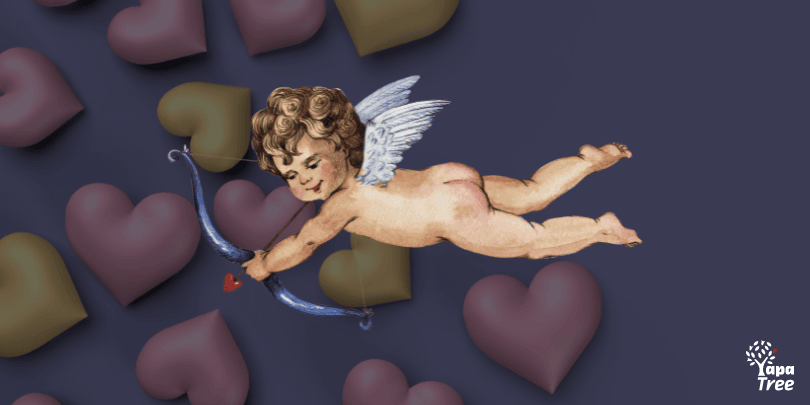
Long associated with Valentine’s Day is the cuddly little half-dressed cherubic character with his quiver of arrows. He was not always depicted as cherubic. Cupid originated with the Greeks as the God of Love, a stout macho man named Eros. It was the Romans who turned him into the sweet baby angel we think of today.
In both civilizations, Cupid carried arrows tipped in gold and lead. The fable tells us he shot the gold-tipped arrow into someone to arouse their desire or the lead-tipped arrow to ignite their disgust. He shot his arrows into humans and gods, manipulating their emotions as he saw fit. One telling of the fable states that Cupid shot a gold-tipped arrow into Apollo to cause him to fall madly in love with Daphne, followed by a lead-tipped arrow into Daphne to cause her to be disgusted by Apollo. Even so, Apollo followed Daphne wherever she went. Eventually, Daphne is turned into a laurel tree and Apollo can do nothing but wear a crown of laurel leaves.
The Chocolate Explosion
There was a chocolate boom in the 1800s and Ecuador, as the largest producer of cocoa, saw fortunes made almost overnight. This was attributed to the high quality of the cocoa bean found in Ecuador. The first chocolate bar is attributed to Joseph Fry of Bristol, England, who made it in 1847. This quickly elevated the popularity of chocolate around the world.
The boom lasted until 1916 when the Ecuador crop was hit by a fungus, crushing plantations for many years. Abroad, Fry’s Chocolates survived for several generations, eventually merging with their strongest competitor, Cadbury Brothers.
It wasn’t until 1868 when candy-maker Richard Cadbury packaged chocolates in heart-shaped boxes decorated with roses and cupids and sold them on Valentine’s Day. Thus began a new tradition of romance marrying chocolate with Valentine’s Day. By 1894, Milton Hershey joined the chocolate craze by covering his caramels with chocolate. He followed this successful venture in 1907 by making chocolate tear-dropped kisses, a name derived from the smooching noise made by the manufacturing machines.
There was no stopping the craze. Actress Jean Harlow gave chocolate a satin boudoir image in her 1933 film Dinner at Eight, when she posed on a heart-shaped pillow nibbling on the candy. And who can forget the hilarious I Love Lucy episode of Lucy and Ethel working in a chocolate factory, where Lucy is trying to stuff her mouth with the candy as it passes down the assembly line? Others who also linked chocolate with Valentine’s Day were the Whitman and Russel Stover companies. It had become big business.
Chocolate in Cuenca
Locally-made chocolate abounds in Cuenca, in candy shops, restaurants, name-brand stores, the airport, and on almost every block in El Centro. We have numerous chocolate factories and stores making chocolate; the venues are too many to list. Let’s look at two of the more popular ones.
Pacari Chocolate Shop
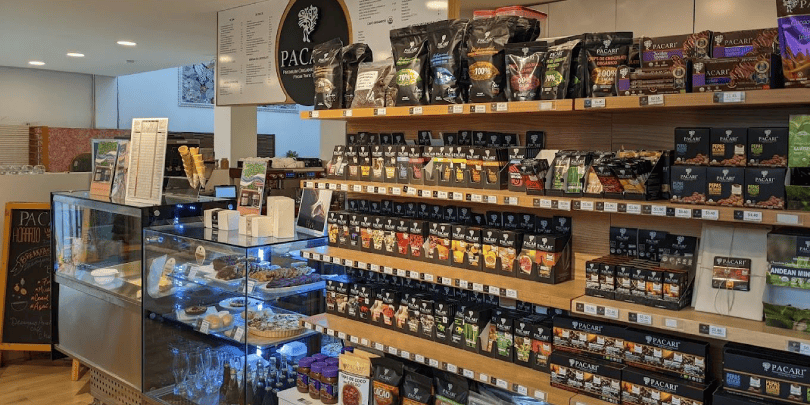
Pacari Chocolate Shop at Paucarbamba 470-488 is both a shop and a restaurant. It began as a dream to make a positive impact on the world. In only six years, this company has won over 200 national and international awards for its chocolate. Pacari is much more than a store/restaurant.
From the beginning, Pacari has operated with a social conscience, developing a mission of organic and biodynamic uses, while at the same time observing fair trade practices. The company sources its cocoa beans directly from 3,500 small-scale farmers and offers educational programs to enhance the farmers’ skills, resulting in a quality product.
Their reputation has not gone unnoticed, witnessed by their international shipments, recognition by chocolate buyers, and even Anthony Bourdain, celebrity chef, who paid a visit to honor Pacari for its product and cultural awareness. I recommend visiting this chocolatier in Cuenca.
By the way, you will impress your chocolate-loving Valentine with this tidbit: A chocolatier is a person or company that makes confectionery from chocolate. Chocolatiers are distinct from chocolate makers, who create chocolate from cacao beans and other ingredients.
Museo del Cacao
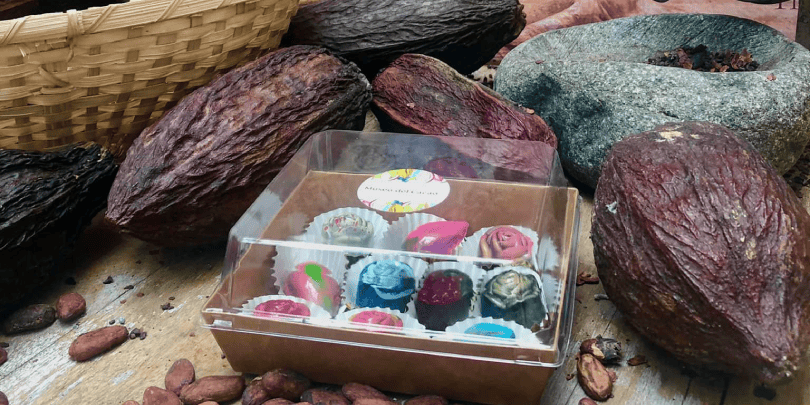
Johanna Cruz chose to open a chocolate store in Cuenca, but she quickly realized most people did not know the origins of chocolate. Therefore, she decided to add an educational element to her store, and the Museo del Cacao was born. The Museum, located at Juan Jaramillo and Hermano Miguel, is open every day from 10:30 to 7:00.
More than buying chocolate at this store, you may take a tour and view how cocoa beans become chocolate. You will discover their chocolate is made by hand without the use of machines, and you will not be able to resist a tasting.
Johanna has created a woman-owned business and sources her cocoa beans from a women-owned farm. She and her crew have expanded their offerings into a wide variety of chocolate forms. Seasonal choices abound, such as hearts and flowers for Valentine’s Day. One of her chocolate guitars would make a perfect gift for any guitar-loving admirer or player.
This Museum is more than a store; it is an opportunity for you to learn more about chocolate – where it comes from, how it is processed, and where you may savor its taste.
Industrial Fátima
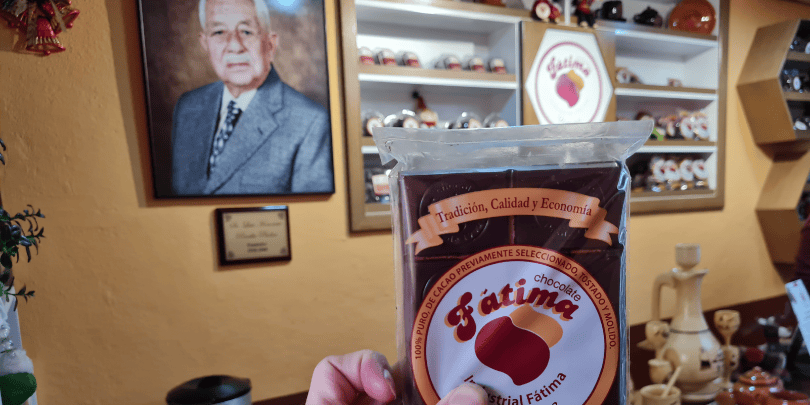
One of the closest (perhaps the closest?) chocolate factories to Cuenca’s el Centro area is Industrial Fátima. They have been producing chocolate here since 1942. And, if you go on one of their tours, you’ll see that it’s largely still being produced the same way. The machinery is brilliant but basic and there is still a lot of manual labor involved. The process is truly fascinating to watch.
They also have a gift shop where you can do some tasting & then buy whatever tickles your tastebuds.
They are located at Calle del Batan 4-56, Cuenca. Tours are by appointment only. Reach them via:
- Facebook: https://www.facebook.com/industrialfatima
- Phone: 099 071 8782
Cuenca Shop
Looking for some quality Ecuadorian chocolate that can be hard to find? Cuenca Shop has many different brands, coming in all sorts of percentages of cacao. YapaTree cardholders get a discount too. Visit this small shop with a large chocolate inventory at Parque San Sebastian.
Wrapping Up
Chocolate reigns supreme in Cuenca and a gift of it is nearly required to make Valentine’s Day complete. We have shared the fascinating histories of Chocolate and Valentine’s Day and how they became the dynamic duo of love – all to assist you in capturing the heart of your Valentine(s).
Chances are excellent that your Valentine’s Day gift of chocolate from Cuenca will melt the heart of your beloved and pave the way to a romantic encounter – which is, after all, the point!




















